
OC 949-428-4500
LA 310-460-2444
Didn’t think it was possible to treat rosacea? Let us show you how it can be done, laser treatment for rosacea works with the body’s own physiology and self-healing power!
At AMA Regenerative Medicine & Skincare, our goal is to eliminate your rosacea once and for all. Through our holistic, multiple modality laser protocols, we can completely remove even the most severe rosacea and help you put a beautiful, rosacea-free face forward to the world once again.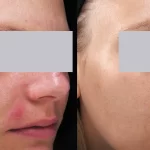
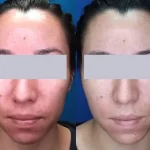
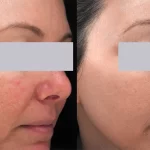




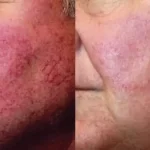


Rosacea is a chronic inflammatory illness and is one of the most common causes of persistent skin redness of the cheeks, chin, nose, and forehead, as well as the eyes. Rosacea can be recognized by repeated flushing, persistent erythema, inflammatory papules/pustules, and spider veins. Secondary signs of rosacea, such as itching, burning, or stinging, are frequently found in patients.
Rosacea is common in both men and women, usually appearing between the ages of 30 and 50. Men are much more likely to develop the progressive disease, especially on the nose.
Rosacea has a negative impact on one’s quality of life and can cause humiliation, low self-esteem, anxiety, and sadness affecting their social and psychological well-being.The exact cause of rosacea is unknown, but it occurs most commonly in patients of Northern European descent with fair skin, and will often run in families. Immune dysfunction, Demodex infection, and UV light exposure are thought to be contributory factors.
Temperature fluctuations, heat, cold, exercise, UV radiation, spicy food, and alcoholic beverages are all flare triggers in rosacea patients.
Aside from rosacea that is associated with unhealthy intestinal bacteria, there are virtually no other causative conditions that have been identified as directly linked to rosacea. Thus, without a specific underlying cause to treat, we are left only with options of targeting the symptoms of the rosacea.The earliest signs of rosacea can be present even in childhood. Most patients are ‘blushers’ who easily flush when stressed, and may be especially sensitive to acne treatment medications or skincare products.
In some patients, this tendency to blush and flush may progress to persistent redness and the appearance of broken capillaries on the cheeks and nose. The redness may deepen and other signs of inflammation may set in, including swelling and pimples, especially on the cheeks and nose (“gin blossom”).
Rarely, chronic inflammation may lead to overgrowth of collagen and sebaceous (oil) glands in the skin on the nose, leading to rhinophyma (a rare disorder involving the thickening of the skin on the nose). In this case, a more intensive rosacea treatment may be required.
The symptoms of rosacea that we are able to effectively treat with lasers include:

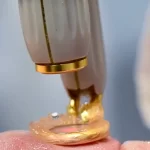
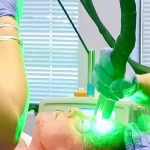
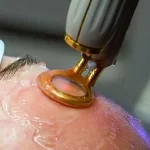






To treat the symptoms of rosacea, far and away the most effective therapy is laser treatment. Depending on how severe your rosacea is, a series of laser treatments are likely to be needed.
Additionally, you are likely to achieve better results from rosacea treatment protocols that utilize more than one type of laser. This is due to the fact that more severe cases of rosacea typically affect many different layers of your skin, each of which is best targeted by different types of lasers.
For instance, a physician that uses a Long-Pulse Dye laser along with a YAG laser is likely to achieve significantly better results than using either one of those lasers by itself.
RF Microneedling used in combination with a pulsed dye laser achieves excellent results in treating recalcitrant papulopustular rosacea.
AMA Regenerative Medicine & Skincare’s innovative rosacea treatment protocol for this inflammatory disorder incorporates all our holistic laser methods of effectively controlling and lessening the symptoms of the rosacea.
This allows your skin can heal naturally from the inside out. We call this a “multiple-modality” use of lasers. More difficult acne rosacea treatments may require photodynamic therapy.
Studies have shown that photodynamic therapy is an effective and safe treatment for erythematotelangiectatic or papulopustular rosacea.Where many physicians fall short is that they focus solely on treating the vascular components of rosacea. As lasers are very target specific, specific types of lasers are very effective in removing all sorts of vascular lesions such as spider veins and broken capillaries.
However, to heal skin that has been suffering from rosacea for a long time, repairing the upper collagen layers of the dermis is important to address. The collagen matrix within these layers will become damaged and weak due to the chronic inflammation associated with rosacea. As a result, the skin becomes uneven and bumpy, and is likely to prematurely age, sag and wrinkle.
A. By far, laser treatment for rosacea is the most effective medical treatment. When properly performed, laser treatment can remove the vasculature in the skin that is visible such as spider veins and broken capillaries. Laser treatment will also significantly reduce the flushing and blushing you are referring to.
It is important to understand that rosacea is often times not just a problem of the surface layers of the skin (epithelium). It is often caused by weakness in the collagen layers deeper in the dermis of the skin as well. For treatment to be effective, lasers to treat the vasculature and lasers to strengthen the deeper collagen are needed. If the underlying collagen is not treated, the rosacea tends to return much more quickly.
A. Based on your description and without seeing you in person it is very hard to make a recommendation. However, typically, IPL treatments by themselves are not very effective as a treatment for rosacea. A fractional C02 laser will likely give you much better results.
As far as side effects, if the practitioner has assessed your skin properly and used the correct settings for the laser, it is very rare to have any negative side effects.A. About rosacea… The frustrating news is that the exact causes of rosacea are not known, and are associated with numerous other conditions including an over-reaction or hypersensitivity to some medications. The good news is that with advanced laser technology rosacea is actually easy to treat. Typically 3-5 sessions – depending on severity – is all that is needed to chase the condition away. For best results, the treatment protocol needs to address two aspects of the skin:
1. The surface layer of the skin where the redness is showing up (epithelium). Removing the excess blood vessels in this layer will make the redness go away.
2. Often rosacea is also associated with a weak collagen matrix in the dermis underneath the epithelium. Thus, laser treatments that strengthen this layer of collagen will help keep rosacea from recurring for the long term.
Both of these laser treatments can occur during the same visit to our office, and with a bit of topical anesthetic, they are not painful. Your face will be sunburn red for a few days after each treatment. We have successfully treated thousands of patients with varying degrees of rosacea.
A. A good and simple question, whose answer is very complex. Because every patient presents with different physiological conditions, considerations and needs, every protocol should be customized. Thus, my answer to you will address the basic and general aspects of Rosacea treatments.
To address surface vascularization, a KTP 532 laser or Long Pulse Dye (Vbeam 595) are both effective. As the Vbeam has slightly longer wave length, is will reach deeper tissue. However, many KTP lasers offer a greater range of pulse duration and spot size that allow for a more precise treatment with less downtime. Power setting (fluence) is a balance between efficacy and downtime. For instance, you are much more likely to produce bruising (“purpura”) using a Vbeam.
Deeper Rosacea will require even longer wave lengths such as those produced by a NdYag 1064.
What many practices overlook, is the need to strengthen the collagen matrix of the upper layers of the dermis. In our experience, Rosacea is always associated with degradation of this layer, and thus for superior and long-term results, Rosacea protocols need to include treating this layer. For this the fractional CO2 is perfect… However, in sever cases, the vascularization needs to be cleared up before the fractional CO2 should be used. Generally, a series of 3-5 treatments will produce fabulous results.A. Great question. Yes! All skin types with Rosacea can be helped with laser therapy. There are a number of different types of lasers that can be used in these conditions.
What is important to understand, is that both the surface vascularization of the surface epidermis AND the upper layers of the collagen matrix of the dermis below must be treated for long term optimal results. Thus, we have two different target tissues that require very different kinds of lasers. Lasers that target vascular tissue, and lasers that target collagen.
Then depending on the severity of the Rosacea, and the melanin content of the skin, a protocol needs to be customized to care for the patient’s skin.
I hope this answer helps… as you can see, there are many factors to consider, so it is very difficult to recommend specific lasers without having the patient’s skin to evaluate first hand.
Everything on our website comes from from reputable publications, books and scientific journals, most of which are available on PubMed and other government websites. These include Meta-Analysis’, Randomized Controlled Trials, Clinical Trials, Systematic Reviews, Books and Documents. We encourage you to read the science, in order to separate fact from fiction, so that you can arrive at a full understanding of what is best for your skin. We would be honored to be a part of that educational journey with you.
AMA Regenerative Medicine & Skincare | 1570 Brookhollow Dr., Santa Ana, CA 92705 | 6310 San Vicente Blvd STE 285, Los Angeles, CA, 90048 | Privacy Policy